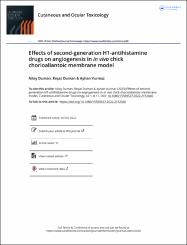| dc.contributor.author | Duman, Nilay | |
| dc.contributor.author | Duman, Reşat | |
| dc.contributor.author | Vurmaz, Ayhan | |
| dc.date.accessioned | 2023-05-05T14:05:18Z | |
| dc.date.available | 2023-05-05T14:05:18Z | |
| dc.date.issued | 2022 | en_US |
| dc.identifier.citation | Duman, N., Duman, R., & Vurmaz, A. (2023). Effects of second-generation H1-antihistamine drugs on angiogenesis in in vivo chick chorioallantoic membrane model. Cutaneous and Ocular Toxicology, 42(1), 8-11. | en_US |
| dc.identifier.issn | 1556-9535 | |
| dc.identifier.uri | https://dx.doi.org/10.1080/15569527.2022.2152040. | |
| dc.identifier.uri | https://hdl.handle.net/20.500.12933/1511 | |
| dc.description.abstract | Background: Literature on the effects of second-generation H1-antihistamines on angiogenesis is limited.
Objectives: To investigate the effects of cetirizine, desloratadine, and rupatadine (second-generation H1-antihistamines commonly used in dermatology clinics) on angiogenesis in an in vivo chick chorioallantoic membrane (CAM) model.
Methods: The study was approved by the local ethics committee on animal experimentation. Forty fertilized specific pathogen free eggs were incubated and kept under appropriate temperature and humidity control. Drug solutions were prepared in identical concentrations by dissolving powders in phosphate-buffered saline (PBS). On the third day of the incubation, a small window was opened on the CAM and 0.1 mL desloratadine (1.5 μg/0.1 mL) in the first group, 0.1 mL cetirizine (1.5 μg/0.1 mL) in the second group, 0.1 mL rupatadine in the third group (1.5 μg/0.1 mL), and PBS (0.1 mL) in the fourth group were administered by injection. On the eighth day of incubation, the vascular structures of the CAMs were macroscopically examined and standard digital photographs were taken. The digital images were analyzed and data including mean vessel density, thickness, and number were compared between groups. p < 0.05 was considered statistically significant.
Results: Vessel densities were similar in the desloratadine, cetirizine, and control groups, whereas they were significantly less in the rupatadine group (p = 0.01). Furthermore, the rupatadine group had significantly lower vessel thickness and number compared with the other groups (p < 0.05 for both).
Conclusions: Rupatadine showed anti-angiogenic effects in the chick CAM model, compared with desloratadine and cetirizine. The anti-angiogenic effect of rupatadine could be due to its platelet-activating factor (PAF) receptor inhibition. Thus, rupatadine could be a treatment agent in pathological processes in which angiogenesis is responsible. Further studies with larger series are needed to clarify this potential. | en_US |
| dc.language.iso | en | |
| dc.publisher | Informa Healthcare | en_US |
| dc.relation.ispartof | Cutaneous and Ocular Toxicology | |
| dc.rights | info:eu-repo/semantics/embargoedAccess | en_US |
| dc.subject | Second-Generation H1-Antihistamines | en_US |
| dc.subject | Angiogenesis | en_US |
| dc.subject | Cetirizine | en_US |
| dc.subject | Desloratadine | en_US |
| dc.subject | in Vivo Chick Chorioallantoic Membrane Model | en_US |
| dc.subject | Rupatadine | en_US |
| dc.title | Effects of second-generation H1-antihistamine drugs on angiogenesis in in vivo chick chorioallantoic membrane model | en_US |
| dc.type | Article | |
| dc.identifier.orcid | 0000-0002-1840-2900 | en_US |
| dc.department | AFSÜ | en_US |
| dc.institutionauthor | Vurmaz, Ayhan | |
| dc.identifier.doi | 10.1080/15569527.2022.2152040 | |
| dc.identifier.volume | 42 | en_US |
| dc.identifier.issue | 1 | en_US |
| dc.identifier.startpage | 8 | en_US |
| dc.identifier.endpage | 11 | en_US |
| dc.relation.publicationcategory | Makale - Uluslararası Hakemli Dergi - Kurum Öğretim Elemanı | en_US |
| dc.identifier.pmid | 36469932 | |
| dc.identifier.scopus | 2-s2.0-85144042113 | |
| dc.identifier.scopusquality | Q3 | |
| dc.identifier.wos | WOS:000893873500001 | |
| dc.identifier.wosquality | Q4 | |
| dc.indekslendigikaynak | Web of Science | |
| dc.indekslendigikaynak | Scopus | |
| dc.indekslendigikaynak | PubMed | |
















